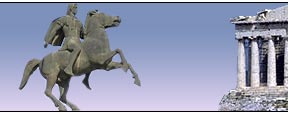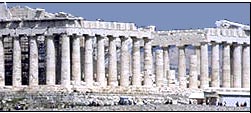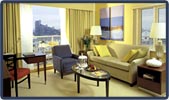The capital of Macedonia and second largest city of Greece, Thessaloniki was first established in 316 BC by Kasandros and named after his wife, Thessaloniki, sister of Alexander the Great. It is here that Paul, the Apostle of Nations, first brought the message of Christianity and that Demetrius, a Roman officer died in martyrdom, thus becoming the holy patron of the city forever. Thessaloniki, Greece becomes the second important city of the Byzantine Empire, next to Constantinople, ornamented with numerous majestic and glamorous architectural works that display all forms of Byzantine art.
Thessaloniki is a lively modern city bustling with life and movement. Large avenues, parks and squares, lines of trees that frame commercial streets with showy shop-windows. Yesterday meets today at old tavernas, "ouzeries" restaurants next to hotels and luxury bars, "bouzouki halls" ( Thessaloniki is the cradle of modern Greek popular song, "rembetiko"), cinema halls, theaters and confectioner's shops that arrange their seats and tables on street pavements and squares.
The modern era of material and cultural development in Thessaloniki dates from its liberation in 1912, when Thessaloniki became the capital city of Northern Greece. The Ministry of Northern Greece, the Cathedral, the Court of Justice, in addition to other major government institutions, are situated today in the city. The town has today two quite distinct sectors: The "old town", continuously undergoing reconstruction, and the modern sector, whose many modern buildings are examples of advanced architecture.
Today, Thessaloniki 's population is almost exclusively made up of Greek inhabitants. Its grounds are a patch work of different commercial, and cultural influences. The city is divided in two by the International Trade Grounds and the Aristotle University. From there, all the way to the waterfront one finds the boulevards, shopping areas, and night clubs of the cosmopolitan Thessaloniki. The west part of the city is dominated by the industrial area and it is densely populated, while the east end includes Touba and Kalamaria areas which were rebuilt after the fire of 1917 and still retain much of its original character. The upper town (Ano Poli) developed around the castle (Genti-Koule) and the Acropolis offer narrow street taverns and beautiful panoramic views of the entire city.
Click here to Book Thessaloniki Hotels |







